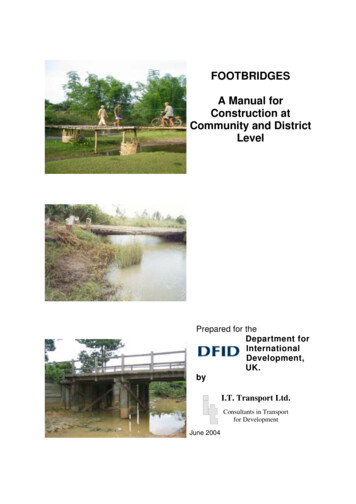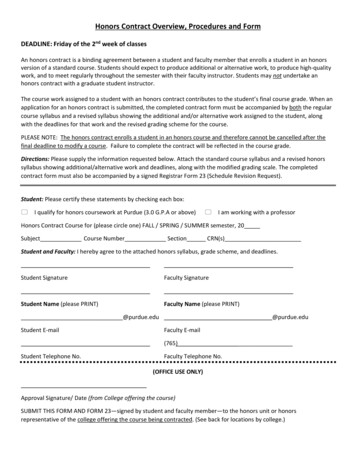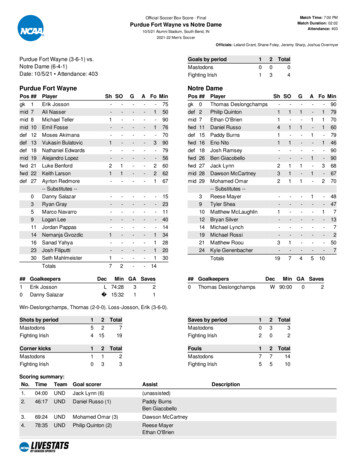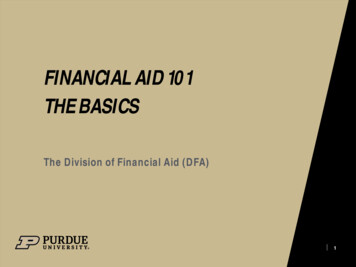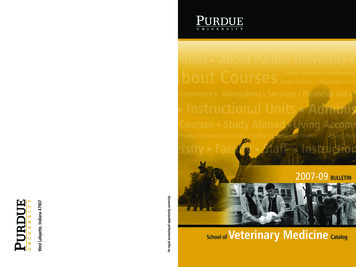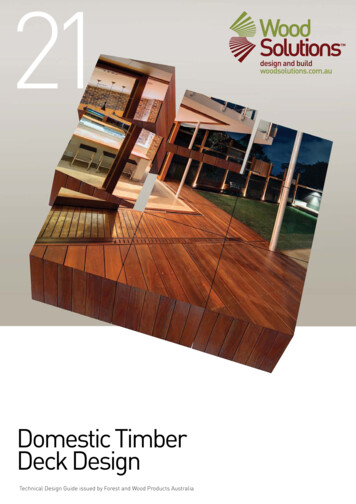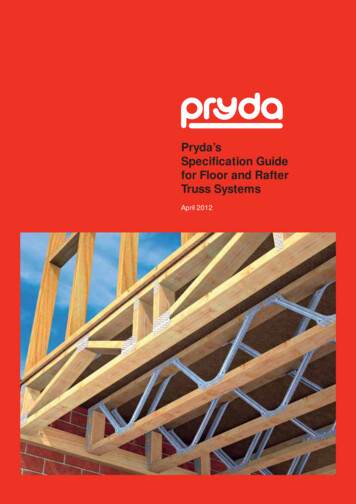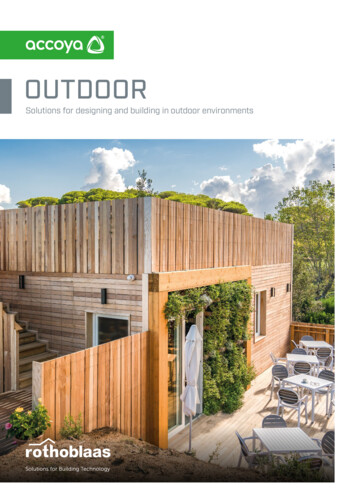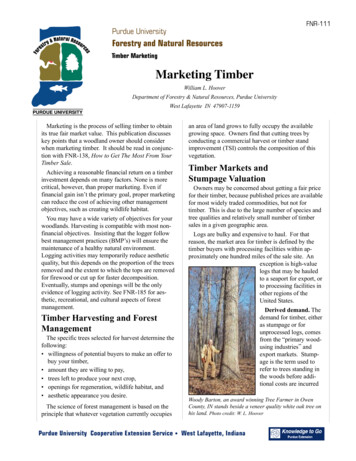
Transcription
FNR-111Purdue UniversityForestry and Natural ResourcesTimber MarketingMarketing TimberWilliam L. HooverDepartment of Forestry & Natural Resources, Purdue UniversityWest Lafayette IN 47907-1159Marketing is the process of selling timber to obtainits true fair market value. This publication discusseskey points that a woodland owner should considerwhen marketing timber. It should be read in conjunction with FNR-138, How to Get The Most From YourTimber Sale.Achieving a reasonable financial return on a timberinvestment depends on many factors. None is morecritical, however, than proper marketing. Even iffinancial gain isn’t the primary goal, proper marketingcan reduce the cost of achieving other managementobjectives, such as creating wildlife habitat.You may have a wide variety of objectives for yourwoodlands. Harvesting is compatible with most nonfinancial objectives. Insisting that the logger followbest management practices (BMP’s) will ensure themaintenance of a healthy natural environment.Logging activities may temporarily reduce aestheticquality, but this depends on the proportion of the treesremoved and the extent to which the tops are removedfor firewood or cut up for faster decomposition.Eventually, stumps and openings will be the onlyevidence of logging activity. See FNR-185 for aesthetic, recreational, and cultural aspects of forestmanagement.an area of land grows to fully occupy the availablegrowing space. Owners find that cutting trees byconducting a commercial harvest or timber standimprovement (TSI) controls the composition of thisvegetation.Timber Markets andStumpage ValuationOwners may be concerned about getting a fair pricefor their timber, because published prices are availablefor most widely traded commodities, but not fortimber. This is due to the large number of species andtree qualities and relatively small number of timbersales in a given geographic area.Logs are bulky and expensive to haul. For thatreason, the market area for timber is defined by thetimber buyers with processing facilities within approximately one hundred miles of the sale site. Anexception is high-valuelogs that may be hauledto a seaport for export, orto processing facilities inother regions of theUnited States.Derived demand. Thedemand for timber, eitheras stumpage or forunprocessed logs, comesfrom the “primary woodusing industries” andexport markets. Stumpage is the term used torefer to trees standing inthe woods before additional costs are incurredTimber Harvesting and ForestManagementThe specific trees selected for harvest determine thefollowing: willingness of potential buyers to make an offer tobuy your timber, amount they are willing to pay, trees left to produce your next crop, openings for regeneration, wildlife habitat, and aesthetic appearance you desire.The science of forest management is based on theprinciple that whatever vegetation currently occupiesWoody Barton, an award winning Tree Farmer in OwenCounty, IN stands beside a veneer quality white oak tree onhis land. Photo credit: W. L. HooverPurdue University Cooperative Extension Service West Lafayette, Indiana
FNR-111for cutting them down (felling), cutting the trunk ofthe tree into logs (bucking), and moving the logs outof the woods to be loaded on a truck (skidding).Collectively, these costs are referred to as “loggingcosts.” An additional cost is transportation of the logsto a processing facility (hauling). The “primaryindustry” converts logs into lumber and veneer. The“secondary industry” converts the lumber and veneerinto end products such as furniture, household fixtures, millwork, flooring, pallets, and many others.The value of your stumpage is derived from theamount consumers are willing to pay for these endproducts less the processing costs, for example,Stumpage Value Product Value – Logging Cost –Hauling Cost – Sawmilling Cost – FurnitureProduction CostsProduct specifications. Each industry has uniquespecies, log size, and log-quality requirements basedon its end-product requirements, and processorswithin the same industry may have unique purchasingstandards. Therefore, not all species, sizes, andqualities of logs will be used by any given mill. Thiscreates large price differentials among species andqualities of logs. It also creates the need for middlemen, such as brokers, who specialize in matching theneeds of particular mills with available log supplies.Value factors. In addition to final-product valuesand processing costs, a number of other factors affectthe value of your timber. Species. Differences in value among species can beas much as 1000 percent.Log brokers buy logs from many sources and prepare themfor resale. Here a broker is scaling logs at hisconcentration yard to determine their volume in board feet,Doyle log rule. Photo credit: W. L. Hoover2 Size. Larger trees generally contain more knot-freewood than smaller ones. In general sawtimber-sizedtrees are worth more per unit of volume thanpulpwood-sized trees, and veneer quality trees areworth more per unit volume than sawlogs. Quality. Larger diameter trees with no branch scarson the first 12 to 36 feet of the trunk have moreknot-free wood than trees with many branch stubs. Volume of sale. Fixed logging costs are lower perunit of volume produced as the total volume loggedat one location increases. Fixed costs include roads,construction of a place to load logs (landing),drainage structures, and moving equipment betweenjobs. Lower unit cost means the logger can offermore. A small sale would generally be 25 thousandboard feet (MBF) or less. A large sale would be over100 MBF. Distance to market. The closer the mill is located tothe logs purchased, the lower the hauling costs. Site accessibility. All other things being equal,timber in tracts that are easily accessed by logtrucks is more valuable. Logging difficulty. Steepness of terrain and soilmoisture conditions determine the loggingequipment that can be used and the efficiency ofthis equipment. Market conditions. The market strength for a givenspecies and quality of stumpage varies by season,market cycle, and many other factors. Buyer’s log inventory. When a mill’s log inventoryis low, buyers may offer more for logs to keep theirmill in operation.Sources of price information. Long-term pricetrends for logs purchased by Indiana mills are reported in the “Indiana Forest Product Price Report andTrend Analysis” compiled by Purdue’s Department ofForestry and Natural Resources. It is published in TheWoodland Steward and available on-line at http://www.inwoodlands.org. To be added to The WoodlandSteward mailing list, contact Purdue CooperativeExtension Service, Department of Forestry andNatural Resources, Purdue University, West Lafayette,Indiana 47907-1159, http://www.fnr.purdue.edu (765)494-3583. A quarterly stumpage price report is alsoavailable. It is based on sales in which a consultingforester assisted. This report is available from thesame sources.
FNR-111Ways To Designate Timber To Be SoldIt is important that you and potential buyers understand which trees you intend to sell. Designation canbe based solely on boundary limits, tree diameterlimits, or marks on individual trees. Another methodis to conduct the harvest yourself and sell logs ratherthan selling the stumpage.Area limit. Boundaries are defined, and all thetrees within these boundaries are for sale. This couldbe your entire ownership or a portion thereof. Thismethod may be appropriate if you want to make aclearcut to regenerate species needing direct sunlightor to clear land for conversion to non-forest uses.Otherwise, it is not recommended because of thepotential for misunderstandings with the buyer, andbecause it frequently is not the appropriate timbermanagement practice.Diameter limit. All trees larger than a certaindiameter breast height (dbh) are for sale. Boundariesneed to be defined. This method usually results in“high grading,” that is, cutting only the best trees andremoving smaller diameter trees that may provide thehighest financial return during the next growing cycle.Continual high grading results in the accumulation ofpoor-quality trees and a decrease in the value of theresidual stand, as discussed in FNR-138 and FNR182.Single-tree selection. Each individual tree for saleis marked with paint spots, one at eye level and one atground (basal) level. The basal paint mark remainsvisible on the stump after cutting. When the loggingis completed this allows you to verify that onlymarked trees were cut. This is the method usuallyrecommended by foresters. Factors to consider inselecting harvest trees are discussed in FNR 91 and138.Self-harvest and sale of logs. Conduct the harvestyourself or hire a logger. Both result in selling logs,not stumpage, and greater financial and physical risk.Unless you know the log specifications of buyers inyour area, this method is not recommended. Loggingis a dangerous activity, even for professional loggers.Steps in Marketing TimberThe major steps in marketing timber are as follows:1. Seek assistance from a professional forester,2. Select trees to be marketed considering your forestmanagement and other objectives,3.4.5.6.7.Estimate timber volume and range in value,Determine bid procedures,Advertise the sale,Evaluate offers and select a buyer,Negotiate the timber sale contract with the buyer,and8. Monitor the sale for compliance.1. Professional Assistance.Most landowners probablydon’t market timber veryoften; however, timberbuyers do this for a living.Their employers expectthem to purchase, at minimum cost, timber that meetstheir company’s needs. Assuch, the landowner mostlikely will be at a disadvantage in this process. Assistance from a professionalforester who earns his or her Red oak properly markedliving in part by marketing for sale. White band andtimber for landowners isbasal spot were made by arecommended. In Indiana, consulting forester. Circlelimited marketing assistance was made by timber buyerwho assessed marked timberis available at no chargefor possible bid. Photo credit:from District ForestersW. L. Hooveremployed by the IndianaDepartment of Natural Resources (IDNR), Division ofForestry. Complete marketing service is available, fora fee, from private, self-employed, consulting foresters. Directories of district and consulting foresters areavailable at county Extension offices, at http://www.inwoodlands.org and at district forester’soffices.2. Select Trees to be Marketed. See FNR-138,Tips on How to Get the Most From Your TimberHarvest and FNR- 91, Financial Maturity: A Guide ToWhen Trees Should Be Harvested. Providing buyerswith a species and quality mix they will be interestedin buying is part of the timber marketing process. Thisconsideration must be weighed against the many otherfactors influencing the selection of trees to include inthe sale.3. Estimate Volume and Value. After the trees tobe sold are identified, estimate their volume andapproximate quality by species. This should be done3
FNR-111more professional relationship with the logger.Select the winning bidder, or reject all bids. Accepta bid only if you are satisfied the price offered isadequate when compared to the initial estimate andthe other bids, and that the winning bidder istrustworthy and competent. After opening the bids,do not reject them all, and then ask for higher bidsfrom the buyers present. The buyers are not prepared to bid again, and those not present cannotenter the bidding. Selection of the winning bidderis called “awarding the bid.” After awarding thebid, a timber sale contract should be negotiated withthe winning bidder. The winning bidder shouldprovide you with earnest money, or a down payment, at the opening or very shortly thereafter.Cavity in this tree may indicate that it shouldbe removed in the next harvest. However, ifwildlife is an important goal, your forestermay recommend leaving it stand.Photo credit: W. L. Hooverregardless of the designation method used. Thevolume of trees to be marketed for sawlogs andveneer logs is measured in board feet according to theDoyle Log Rule. See FNR-191, Log and Tree ScalingTechniques. Pulpwood is sold by the ton or cord. Usethis volume data and the price estimates to calculate apossible range in fair market value. If you are workingwith a consulting forester, he or she should provideyou with this estimate. Use it only as a guide toevaluate purchase offers or bids.4. Select Bidding Procedures. Oral auction orsealed bids may be used. Sealed bids are the mostcommon. They ease administration of the sale, reducetime spent by you and potential buyers, and protectyour interests by requiring payment of earnest money.Bids are submitted at the time and place you designatein the sale announcement. Sealed bids. Bids may be received by hand delivery, mail, phone, fax, or e-mail. Open them at theappointed time and place. Representatives ofinterested buyers are frequently present. A business-like attitude during bid opening should insure a4 Oral auctions. Interested buyers bid on the timberat a designated time and place. Some believe thisprocedure guarantees interested buyers will bid theprice to the highest level possible. However, manybuyers do not like oral auctions and will not participate in them. They may be appropriate, however, ifyour timber is especially valuable. A variation oforal bidding is to require a written opening bid withearnest money followed by an oral auction for thosewho submitted a written initial bid. Right to refuse all bids. The right to refuse any andall bids should be reserved in the timber saleannouncement. This protects you from having tosell your timber at an unacceptable price or to abuyer with whom you are not comfortable working.However, do not use the bidding process to obtain afree timber appraisal. Buyers will not be receptiveto future sales if you do.5. Advertise Sale. Timber selling becomes timbermarketing only by making certain all potential buyersare made aware of what you have to sell. You mustalso convince buyers that your timber meets theirneeds. The more information you provide, the betteryour chances of getting them to inspect your timberand make an offer.The following information should be included in asale announcement: Legal description (provide a map) of sale area anddesignation of trees for sale, Dates property will be available for inspection, Date, time, and place bids will be received andopened, or an auction held,
FNR-111 Who marked the timber, Address where bids or offers should be sent, and Right to refuse any or all bids or offers. If sale trees have been marked individually, providea list of the number of trees by species and volume.If the sale trees are not marked, provide an estimateof total volume. In either case, provide an estimateof quality. List of contract provisions and form of sale desired,and Other items you believe pertinent to the sale shouldbe listed.Names and addresses of timber buyers are availablefrom the Indiana Division of Forestry. They maintaina list of all firms and individuals licensed to buytimber in Indiana. The sale can also be advertised inyour local newspaper. The best outlet, however, is theIndiana Licensed Timber Buyers Bulletin. It ispublished monthly by the Indiana Division of Forestryand sent to all companies and individuals licensed topurchase timber in the state. This free service isoffered to assist woodland owners in locating marketsfor their timber products and to aid licensed buyers inlocating sources of timber.Timber Sale Contract. There are two basic typesof timber sale contracts: “lump sum” and “pay-ascut,” as well as variations of these basic types. Lump sum. The buyer agrees to pay a fixedamount. The advantage to you is that the amount isnot dependent on any future event, such as damageto the standing timber, timber theft, or overestimation of the value of the timber. Generally, youshould be paid the full amount due prior to the startof the harvest; however, you may contract toreceive installment payments on designated futuredates. In this case, it is appropriate to requireinterest on the deferred payments. The schedule ofpayments and interest should be specified in detailin the written contract. If you are not paid interest,the Internal Revenue Service may require that youreport a portion of your gain as ordinary incomeinstead of as capital gain.The lump-sum contract is recommended for mostIndiana timber owners. It does not depend on thelogger or other party to tell you how much timberhas been cut; however, special marketing condi-tions may make another form appropriate. Forexample, if you are marketing low-quality timber aspart of a timber stand improvement, a sharescontract may be the only way to sell it. Pay-as-cut. You retain title to the timber until it iscut. This is also referred to as an “economic interestretained” contract. The buyer agrees to purchasetimber at a given price per unit volume of the cutproduct, usually logs. The contract price per unitmay be an average or per species and log grade.The determination of the volume and grade of thelogs cut is an administrative burden. Frequentinspection by you or your agent may be requiredduring logging to assure an accurate accounting. On-the-shares. You agree with a logger to sharethe money received from selling the logs producedfrom your timber. The split is usually a fixedpercentage for you and for the logger. For administrative and tax purposes, it is important to specify ina written contract the relationship between you andthe logger. Logging service. You pay the logger a set fee perunit volume to cut and haul the timber to a logbuyer you designate. The logs belong to you untilyou sell them. To prevent discrepancies betweenyour estimate of timber volume cut and the volumedelivered to a mill, it may be necessary for you oryour agent to measure the logs at the loading pointin the woods (the landing) before the logs areloaded and hauled to the buyer.Modern logging equipment like this feller-buncher cuts thetree, bucks logs, and piles logs to be picked up by anothermachine and hauled to log landing.Photo credit: W. L. Hoover5
FNR-111 Written contract strongly recommended. To reducethe possibility of misunderstandings and disagreements, a written contract between buyer and selleris essential. “Handshake” agreements are not agood business practice and may not be enforceablein a court of law. Timber buyers and foresters canprovide you with a standard timber sales contract,but be certain to review it for the specific terms youagreed to. A sample contract is included at the endof this publication. An attorney should prepare andexecute the contract. Restrictions on both the buyer and you, if any.Examples might include the following:— You cannot enter into additional contractsinvolving the area of the sale for the periodcovered in the contract without the buyer’spermission.— Activities are to cease if certain weather conditions occur, such as extreme drought creating afire hazard, or heavy rainfall that results insevere rutting by logging equipment. Legal note. Standing timber, like land, is realproperty. However, Indiana statutes provide thattimber subject to a contract of sale which calls forthe buyer to remove the timber within a reasonableperiod of time is subject to the provisions of theUniform Commercial Code, rather than the provisions for the sale of real property. This means thatit is not necessary to register the contract at thecounty courthouse, but it may be in your interest todo so. It is also in the interest of the buyer to havethe contract registered in case title to your landchanges prior to the removal of the timber. Checklist of contract provisions. The followingchecklist contains important provisions to include in acontract. A statement that you, the seller, are the lawfulowner of the property conveyed to the buyer, andthe identification of any other co-owners must beincluded. If you do not have legal authority tosell the timber without consent of other coowners, their signatures will be required on thecontract. The buyer and his employees have the right ofaccess as necessary to perform their functionsunder the contract. Transfer or exchange of the property from youand any other co-owners to the buyer. Total amount to be paid by the buyer, if a lumpsum amount, or price per unit volume, and theprocedure for determining the volume harvested. Date payment is due, or schedule of payments, ifmore than one payment is to be made. Legal description of the land, location of accesspoints, information on access easements, if any. Description of how the trees sold are designatedor marked.6Logging during very wet weather and in areasadjacent to streams can cause severe rutting andsedimentation of streams. Photo credit: W. L. Hoover Provisions for damage to residual trees and/orexisting improvements from the harvest operation. How will these be assessed and for whattypes of damages must you be reimbursed? Provision for the cutting of trees not sold in thecontract. Status of sold but uncut trees. Must all markedtrees be cut? Requirement for all activities to be conductedaccording to Indiana Best Management Practices(BMP’s). This usually means selling your timberonly to a buyer who uses loggers who havereceived BMP training. You may also want togive preference to buyers participating in theSustainable Forestry Initiative (SFI) sponsoredby the Indiana Forest Industry Council (IFIC). Inaddition to requiring compliance with BMP’s,you may want to contract specifically for,— The location of logging roads and skid trails,— Road construction specifications, and
FNR-111— Post-logging road and skid trail closure, including the installation of water control devices andseeding. How long the contract remains in effect. Specifythe total number of days or a termination dateand how an extension of this date may bearranged. Reasons for extensions could includewet weather, prevention of crop damage, orconflicting uses at various times of the year.If there are any questions or complaints, immediatelynotify the logger on the site and the buyer if different.Attempt to rectify the problems at once; usually theycan be worked out without a third party. Disclaimer of your liability for personal injuryduring the buyer’s performance under thecontract. You should require the buyer to carryinsurance to guarantee his or her ability to pay ina liability case. State this requirement in theannouncement of the timber sale.When hiring a forester, ask if he or she will monitorthe logging operation in progress and inspect the siteupon completion. Consider contracting for the foresterto be on site when the final BMP practices are beinginstalled. Methods of modifying the contract, and theconditions for a resale. Require an on-site pre-logging conference withthe seller, the logger, and a consulting forester toclarify expectations and avoid misunderstandings. If you choose to rely on arbitration instead ofcourt action in case of a dispute, specify thearbitration procedures to be followed. Signatures. Read the contract carefully beforesigning it. Be sure that you and the buyerunderstand and agree on all the provisions of thecontract. You’ll also need to have the signatureswitnessed.Other ConsiderationsMany other activities must be carried out to assure atrouble-free timber sale.Notify Adjoining Land Owners. Owners of landadjoining the woodland to be harvested should benotified. Offer to walk adjoining property lines withthem. Let them know how to contact you or yourdesignated representative if they suspect inappropriateactivity is occurring.Monitoring the Sale for Compliance. You and anyrepresentative you designate have the authority andresponsibility to inspect operations as long as you doso in a safe manner. Always announce your presenceto logging crews when you come onto the site.Monitoring ensures that all contract provisions arebeing met, that only timber designated for harvest isremoved and that unnecessary damage is prevented.After all cutting is completed, make a final inspection of the property to ensure all contract violationsare corrected or compensated for. Send a letter to thebuyer stating all provisions of the contract have beenmet and the buyer is released from further obligations.Sell Only to Licensed Buyer. All persons and firmsthat buy timber in Indiana, including out-of-statebuyers, are required to have a registration certificateissued by the Indiana Department of Natural Resources, Division of Forestry. This license must berenewed annually. Each licensed buyer and registeredagent is furnished an identification card giving his orher name, the person or company for whom he or sheis buying, business address, and license number.“Timber” is defined as trees, standing or felled, andlogs which can be used for sawing or processing intolumber. Firewood, Christmas trees, fruit, and ornamental trees are not included.Licensed timber buyers are required to post a suretybond or certificate of deposit with the Department ofNatural Resources. In the event a buyer fails to payfor timber purchased, or fails to pay legally determined damages for timber wrongfully cut, you canseek restitution by forfeiture of this bond.Minimize Income Tax. The time to consider taximplications is before the timber marketing processstarts. Favorable tax treatment depends on how thetimber is sold, and determination of the total volumeof timber on your land, as well as the volume sold.The gain from selling stumpage is usually eligible forlong-term capital gains treatment. Profit from sellinglogs is not, unless you elect to treat the cutting as asale under Sec. 631(a) of the Internal Revenue Code.You may also be able to recover your investment inthe timber sold by claiming a depletion allowance.This allowance is based on the amount you paid forthe timber or its fair market value on the date of deathof the person from whom you inherited it.7
FNR-111Please note that timber sale income is subject toFederal and state income tax even if the buyer doesnot send you an IRS Form 1099. This applies whetheryou are paid by check or in cash.For complete details consult the National TimberTax Website at http://www.timbertax.orgPost-harvest Investment. Achievement of yourobjectives may require additional monetary investment, and your timber harvest income may make thisfeasible. Examples of post-harvest investments aretree planting, wildlife habitat improvements, fencingto restrict grazing, road improvements, or timber standimprovement (TSI). A review of your future plans is agood idea following a timber harvest, as discussed inFNR-181.Best Management Practices (BMP). These areguidelines loggers follow to minimize the impact oflogging on water quality. The focus is on sedimentation of waterways from soil erosion both during andafter logging. You can review BMP’s by requestingan Indiana BMP Guidebook from the Indiana Divisionof Forestry or on line at http://www.state.in.us/dnr/forestry/bmp/log1.htm BMP’s are also discussed inFNR-184.Decay of logging slash less than two years after theharvest. Photo credit: W. L. Hoover8Excellent regeneration 10 years after a salvage harvestnecessitated by a severe wind storm.Photo credit: W. L. HooverSummarySatisfactory timber sales are the result of planning.Organization and patience are essential. Buying andselling timber is more than just wheeling and dealingover price. It is a business transaction and a criticalstep in the implementation of your forest managementplan. Properly conducted timber harvests that areprofitable to the landowner are the key to retainingIndiana’s forests. Your ability to make money fromyour timber will prove to other forest landowners thatit is not necessary to subdivide and develop forestlandto make a profit.
FNR-111Related PublicationsContact your county Extension Educator or AgCommunication, Media Distribution Center, 1187Service Building, Purdue University, West Lafayette,IN 47907, or call toll free at (888) 398-4636. Most ofthese publications are also available on line at: -4FNR-84FNR-86FNR-87FNR- 1How to Make and Use the TreeMeasuring StickHardwood Log Grades and LumberGrades: Is There a Relationship?The Economics of Timber StandImprovementForestry and Wildlife ManagementAssistance Available to IndianaWoodland Owners: Providers andProgramsFinancial Maturity: A Guide to WhenTrees Should Be HarvestedTimber Harvesting and LoggingPractices for Private WoodlandsHow to Get the Most From YourTimber SaleA Landowner’s Guide to SustainableForestry in Indiana, Part 2. Planningfor the FutureA Landowner’s Guide to SustainableForestry in Indiana, Part 3. KeepingYour Forest Healthy and ProductiveA Landowner’s Guide to SustainableForestry in Indiana, Part 5. Forestsand WaterA Landowner’s Guide to SustainableForestry in Indiana, Part 6. Maintaining the Aesthetic Beauty andEnhancing the Recreational andCultural Values of Your ForestLog and Tree Scaling Techniques9
FNR-111TIMBER SALE CONTRACT (lump sum)(example only, legal counsel should be consulted)Note: Seller and Purchaser should initial and date each page of a multiple page contract.Contract entered into this day of , 20 , by and betweenof Indiana hereinafter called Seller, andhereinafter called the Purchaser,WITNESSETH:1. Seller agrees to sell and Purchaser agrees to buy for the total sum of Dollars( ) under the conditions set forth in this contract all standing timber marked for cutting upon anarea of approximately acres in the of Section TWP, County, Indiana on land owned and recorded in the name of. The location of the area can further be described as follows:. Purchaser further a
Woody Barton, an award winning Tree Farmer in Owen County, IN stands beside a veneer quality white oak tree on his land. Photo credit: W. L. Hoover an area of land grows to fully occupy the available growing space. Owners find that cutting trees by conducting a commercial harvest or timber stand improvement (TSI) controls the composition of .


